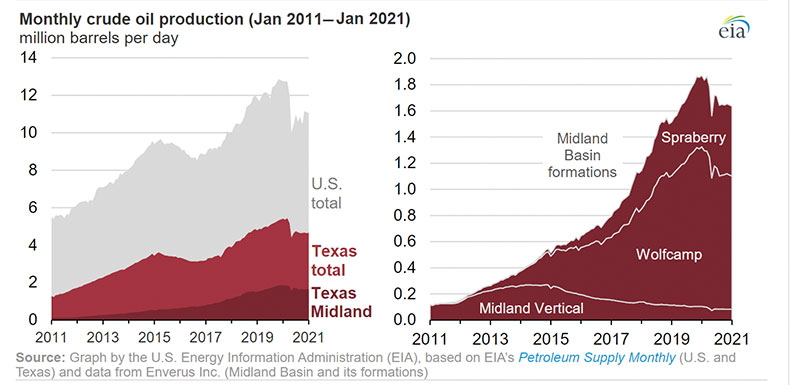October 2021, Vol. 248, No. 10
Features
Texas’ Midland Basin Accounts for 15% of US Crude Oil in 2020
By Energy Information Administration (EIA)
Texas’s Midland Basin, part of the larger Permian Basin, which spans parts of western Texas and eastern New Mexico, is made up of many stacked hydrocarbon-bearing formations.
Production increases from the Permian Basin (particularly the Midland Basin) contributed to record U.S. crude oil and natural gas production in 2019. In 2021, as the industry continues to work through issues related to reduced consumption due to the COVID-19 pandemic, natural gas production has returned to average levels faster than crude oil production because of rising natural gas prices and more demand to support U.S. exports from the region.
The Midland Basin is in the eastern Permian Basin and is within Texas’s borders. During the last decade, hydrocarbon exploration and production in the Midland Basin were driven by development of the organic-rich, lower permeability units within the Wolfcamp and Spraberry formations.
Reservoirs of the basin have been a target for vertical drilling since the 1940s, and vertical drilling generated most of the basin’s production until the mid-2010s. As a result of technological advances in horizontal drilling and hydraulic fracturing, shale intervals of the Spraberry and Wolfcamp formations became the main targets for exploration and production.
Production from vintage vertical wells, many of which access the Spraberry and Wolfcamp formations, accounted for about 6% of total hydrocarbons produced from the Midland Basin in 2020.
The Midland Basin generated 1.68 million bpd of crude oil and 5.4 billion cubic feet per day (Bcf/d) (153 MMcm/d) of dry natural gas in 2020, accounting for about 15% of total crude oil production and about 6% of total dry natural gas production in the United States, according to Enverus Inc.
In 2020, as economic conditions and other factors related to the COVID-19 pandemic caused domestic crude oil prices to fall to their lowest levels in years, operators in the Midland Basin used financial, operational and technological mechanisms to maintain production under challenging market conditions. Crude oil and natural gas production across Texas also reached temporary lows in February 2021 because of a cold snap that caused electricity outages across the state.
Midland Basin production reached a low of 1.5 million bpd of crude oil and 4.9 Bcf/d (139 MMcm/d) of dry natural gas in May 2020, but production has since increased. In January 2021, the Midland Basin generated 1.6 million bpd of crude oil, which was 5% more than its May 2020 low but 10% less than its monthly peak reached in February 2020.
By comparison, Midland natural gas production peaked in late 2020 and reached an all-time high of 5.8 Bcf/d (164 MMcm/d) in October 2020, when new pipeline takeaway capacity out of the Permian Basin entered service.
At the end of July 2021, 107 drilling rigs and 28 fracking crews operated in the Midland Basin, according to Enverus Inc. At that time, the Midland Basin accounted for 44% of all rigs operating in the Permian Basin and 22% of all rigs operating in the United States.
The Midland Basin’s rig count fell to as low as 58 active rigs last summer, when low crude oil prices led to drastic reductions in drilling operations.







Comments